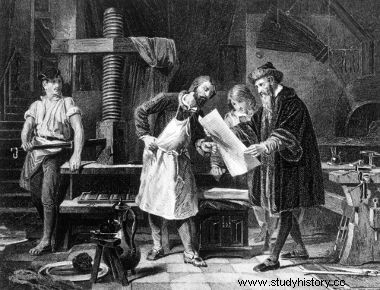
By Me. Cláudio Fernandes
Like the invention of the telescope by Galileo Galileo, in the 17th century, revolutionized astronomy, the invention of the printing press on movable type, better known as press , by the German Johannes Gutenberg , in the 15th century, provoked an enormous revolution in modernity:the process of accelerating the production of books. After the invention of the printing press, printing and composing books ceased to be manual and artisanal practices and became a mechanized serial production.
Gutenberg developed his invention around the year 1430. Gutenberg's printing machine had a board on which movable types, or characters, were arranged. These movable types were nothing more than graphic symbols (letters, numbers, dots, etc.) cast in lead. A single ink-fed mold of these types could print countless copies of the same text in a matter of hours. If in the manual elaboration of the books (which were called codex , or codex ), the time spent was enormous; with the press, this time was greatly reduced.
At the beginning of the 16th century, the effects caused by Gutenberg's press were already perceptible in the German principalities, especially when, through the press, there was the popularization of pamphlets critical of the reformist Martin Luther. The Reform Protestant triggered by Luther in 1517, it began to have a great reception among the literate population of Germany, due to the circulation of theses and printed pamphlets. Subsequently, an even greater contribution by Luther to the history of reading would be “hand in hand” with Gutenberg's press:the translation of the Bible from Latin into German.
With the Bible translated into a vulgar language (in the sense that it was not classical, such as Latin), the demand for its reading also became great, since not all the sixteenth-century literate population mastered Latin. The role of printing on movable type was decisive in suppressing this demand in the shortest possible time. From the 16th century onwards, the printing press (or printing, as it is more commonly said today) became even more sophisticated, as well as the wider, more diversified and sophisticated readership, which generated new questions and new problems regarding of whether or not we are experiencing a new revolution in the field of reading, as French historian Roger Chartier suggests:
“The revolution of our present is certainly more than that of Gutenberg. It not only modifies the technique of text reproduction, but also the very structures and forms of the support that communicates it to its readers. The printed book has been, until today, the heir of the manuscript:in terms of organization in notebooks, the hierarchy of formats, from the libro da banco to the libellus; as well as reading subsidies:concordances, indexes, summaries, etc. With the monitor, which replaces the codex, the change is more radical, since it is the modes of organization, structuring, and consultation of the written support that are modified. A revolution of this magnitude therefore needs other terms of comparison. ” [1]
NOTES
[1] CHARTIER, Roger. From the codex to the monitor:the trajectory of writing . Study ave. [online]. 1994, vol.8, n.21, pp. 187.
